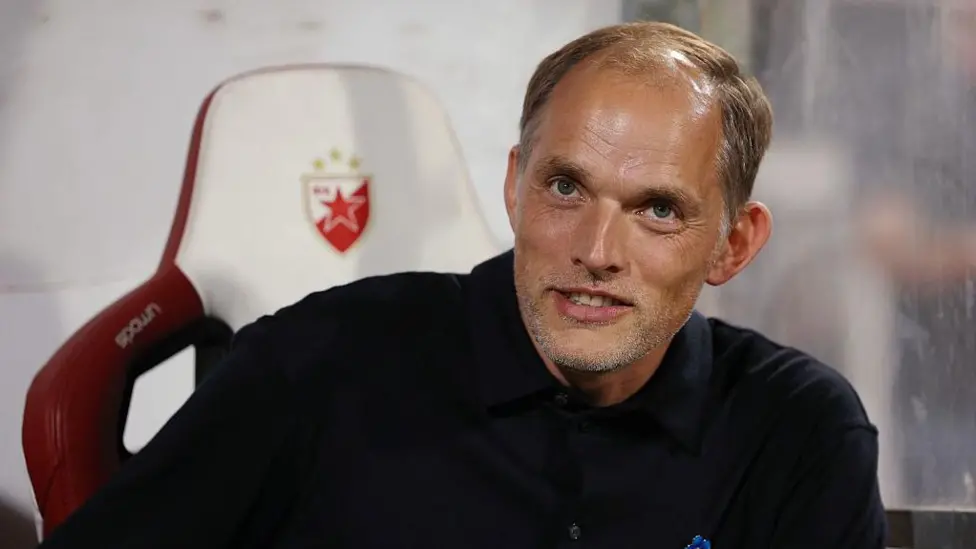
Tuchel’s England: Tactical Progress or Just Hype?
Tuchel’s England Analysed: How Good Are They, Really?
Thomas Tuchel’s England are undefeated in World Cup qualification, and the recent 5-0 demolition of Serbia was their most convincing display to date. Yet, questions still linger: Are England actually getting better? And is Tuchel’s tactical blueprint robust enough to win the World Cup in 2026?
Let’s break down the signs of tactical evolution, key player usage, weaknesses, and Tuchel’s deeper strategy.
Tactical Principles Under Tuchel: A New England Identity?
Tuchel has used a 4-4-1-1 base shape but transitions into dynamic build-up patterns such as:
-
3-2-5: One full-back tucks in with the centre-backs to outnumber a press.
-
2-3-5: Full-backs widen alongside a pivot, giving midfielders like Curtis Jones freedom to push up.
-
2-1-7: Seen in the Serbia match, where England overloaded in advanced areas, enabling vertical progression.
This fluidity allows England to dominate possession while stretching compact defences. Full-backs like Reece James and Tino Livramento have been pivotal in adjusting width and offering build-up support.
Kane, Madueke & the Vertical Threat
Tuchel’s England have embraced riskier forward passes and off-the-ball runs—a far cry from Southgate’s more conservative patterns. Harry Kane continues to drop deep to link play, opening space for fast, aggressive runners like:
-
Noni Madueke – England’s standout wide threat, offering 1v1 flair and penetration.
-
Anthony Gordon & Morgan Rogers – Exploit space behind defences.
-
Myles Lewis-Skelly – Makes deep, timed runs that offset Kane’s static positioning.
This movement adds unpredictability and enhances chance creation, often without relying solely on rehearsed routines.
Tuchel’s Solutions for the “Golden Generation” Curse
England’s past managers have often been shackled by the pressure to play big names. Tuchel has shown pragmatism over reputation, favouring:
-
Anderson and Madueke over legacy starters.
-
Tactical synergy—like pairing Gordon and Livramento, James and Madueke, based on club chemistry.
This shift shows Tuchel is building a team, not just selecting stars.
Attacking Set-Pieces & the Return of the Long Throw
Tuchel isn’t abandoning pragmatic marginal gains:
-
Set-piece innovation was seen in the Kane goal vs Serbia—engineered via zonal overload and a well-timed run.
-
Long throws are back: Tuchel confirmed this is a deliberate strategy to unpick low blocks and force early openings.
These tactics reflect a manager who understands the fine margins of knockout football.
Defensive Stability… With Caveats
England have yet to be truly tested defensively in qualifiers. They’ve pressed well post-loss and defended transitions using the individual strength of players like Marc Guehi and Declan Rice.
However, the 3-1 friendly loss to Senegal exposed:
-
Kane’s limitations in pressing from the front.
-
Vulnerability to quick counters and possession-holding teams.
-
Gaps in Tuchel’s defensive structure when facing composed, dynamic opponents.
This is a warning sign ahead of likely duels with Spain, France, or Brazil next summer.
Smart Squad Use in Limited Time
Tuchel faces a key challenge in international football’s time scarcity. His solutions include:
-
Using domestic teammates to accelerate chemistry (e.g., Gordon-Livramento, James-Madueke).
-
Sticking to familiar systems that allow quick onboarding of key players.
-
Prioritising system-fit players over big reputations.
With just one camp left before naming the final squad, Tuchel is using every moment wisely.
Verdict: Tuchel’s England—Smart Build, Real Promise
So far:
-
Undefeated in qualifiers
-
Tactical identity emerging
-
Greater risk, more verticality
-
Still untested vs elite opposition
-
Defensive structure not airtight under pressure
Tuchel has brought tactical nuance, selective innovation, and a braver attacking approach. Whether it holds up against top sides remains the only unanswered question.
What’s Next?
With stars like Jude Bellingham, Bukayo Saka, and Phil Foden yet to be fully integrated, England’s ceiling remains high.
The Serbia result may be Tuchel’s first real “proof of concept.” But tougher tests are coming—and only then will we know whether this England is evolution or revolution.




























There are no comments yet. Be the first to comment!